GEEKOM A7 mini-PC Review : Premium Phoenix in a Compact 4x4 Package
by Ganesh T S on May 31, 2024 8:00 AM ESTWorkstation Performance - SPECworkstation 3.1
SFF PCs traditionally do not lend themselves to workstation duties. However, a recent trend towards miniaturized workstations has been observed. Despite the dimunitive nature of the GEEKOM A7, its excellent performance in the UL Procyon and BAPCo CrossMark encouraged us to benchmark the system for both content creation workloads as well as professional applications.
The SPECworkstation 3.1 benchmark measures workstation performance based on a number of professional applications. It includes more than 140 tests based on 30 different workloads that exercise the CPU, graphics, I/O and memory hierarchy. These workloads fall into different categories.
- Media and Entertainment (3D animation, rendering)
- Product Development (CAD/CAM/CAE)
- Life Sciences (medical, molecular)
- Financial Services
- Energy (oil and gas)
- General Operations
- GPU Compute
Individual scores are generated for each test and a composite score for each category is calculated based on a reference machine (HP Z240 tower workstation using an Intel E3-1240 v5 CPU, an AMD Radeon Pro WX3100 GPU, 16GB of DDR4-2133, and a SanDisk 512GB SSD). Official benchmark results generated automatically by the benchmark itself are linked in the table below for the systems being compared.
| SPECworkstation 3.1 Official Results (2K) | |
| GEEKOM A7 | Run Summary |
| Supermicro SYS-E102-13R-H | Run Summary |
| ASRock 4X4 BOX-5800U (Performance) | Run Summary |
| Beelink GTR7 | Run Summary |
| ASRock 4X4 BOX-7840U (Performance) | Run Summary |
| Intel NUC12WSKv7 (Wall Street Canyon vPro) | Run Summary |
| ASRock NUC BOX-1360P-D5 (Performance) | Run Summary |
| ASRock 4X4 BOX-7735U (Performance) | Run Summary |
| Intel NUC13ANKi7 (Arena Canyon) | Run Summary |
| ASRock NUCS BOX-1360P-D4 | Run Summary |
| GEEKOM A5 | Run Summary |
| ASRock NUC BOX-1260P | Run Summary |
| GEEKOM AS 6 (ASUS PN53) | Run Summary |
| GEEKOM Mini IT13 | Run Summary |
Details of the tests in each category, as well as an overall comparison of the systems on a per-category basis are presented below.
Media and Entertainment
The Media and Entertainment category comprises of workloads from five distinct applications:
- The Blender workload measures system performance for content creation using the open-source Blender application. Tests include rendering of scenes of varying complexity using the OpenGL and ray-tracing renderers.
- The Handbrake workload uses the open-source Handbrake application to transcode a 4K H.264 file into a H.265 file at 4K and 2K resolutions using the CPU capabilities alone.
- The LuxRender workload benchmarks the LuxCore physically based renderer using LuxMark.
- The Maya workload uses the SPECviewperf 13 maya-05 viewset to replay traces generated using the Autodesk Maya 2017 application for 3D animation.
- The 3ds Max workload uses the SPECviewperf 13 3dsmax-06 viewset to replay traces generated by Autodesk's 3ds Max 2016 using the default Nitrous DX11 driver. The workload represents system usage for 3D modeling tasks.
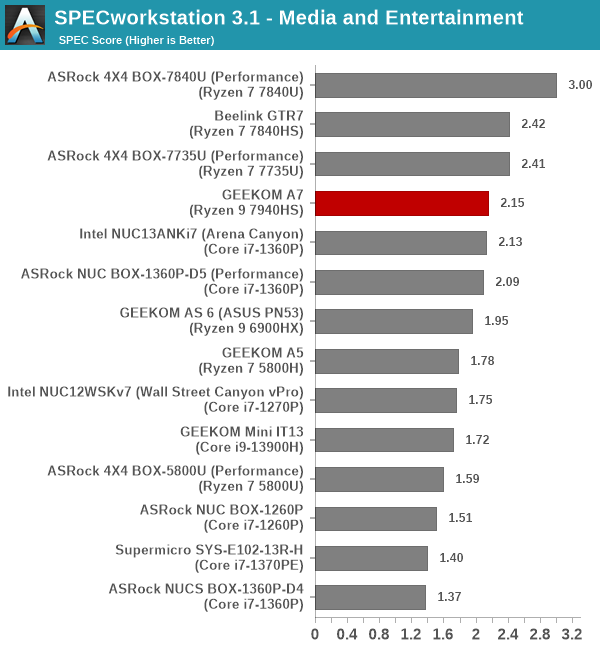
Product Development
The Product Development category comprises of eight distinct workloads:
- The Rodinia (CFD) workload benchmarks a computational fluid dynamics (CFD) algorithm.
- The WPCcfd workload benchmarks another CFD algorithm involving combustion and turbulence modeling.
- The CalculiX workload uses the Calculix finite-element analysis program to model a jet engine turbine's internal temperature.
- The Catia workload uses the catia-05 viewset from SPECviewperf 13 to replay traces generated by Dassault Systemes' CATIA V6 R2012 3D CAD application.
- The Creo workload uses the creo-02 viewset from SPECviewperf 13 to replay traces generated by PTC's Creo, a 3D CAD application.
- The NX workload uses the snx-03 viewset from SPECviewperf 13 to replay traces generated by the Siemens PLM NX 8.0 CAD/CAM/CAE application.
- The Solidworks workload uses the sw-04 viewset from SPECviewperf 13 to replay traces generated by Dassault Systemes' SolidWorks 2013 SP1 CAD/CAE application.
- The Showcase workload uses the showcase-02 viewset from SPECviewperf 13 to replay traces from Autodesk's Showcase 2013 3D visualization and presentation application
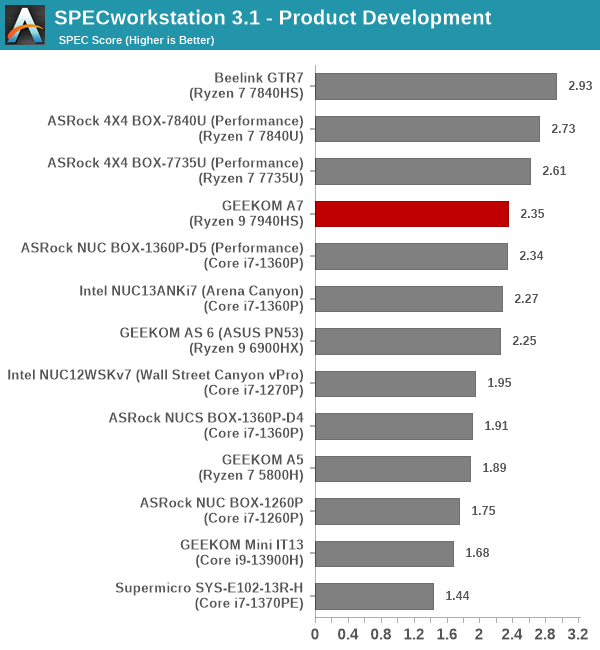
Life Sciences
The Life Sciences category comprises of four distinct test sets:
- The LAMMPS set comprises of five tests simulating different molecular properties using the LAMMPS molecular dynamics simulator.
- The NAMD set comprises of three tests simulating different molecular interactions.
- The Rodinia (Life Sciences) set comprises of four tests - the Heartwall medical imaging algorithm, the Lavamd algorithm for calculation of particle potential and relocation in a 3D space due to mutual forces, the Hotspot algorithm to estimate processor temperature with thermal simulations, and the SRAD anisotropic diffusion algorithm for denoising.
- The Medical workload uses the medical-02 viewset from SPECviewperf 13 to determine system performance for the Tuvok rendering core in the ImageVis3D volume visualization program.
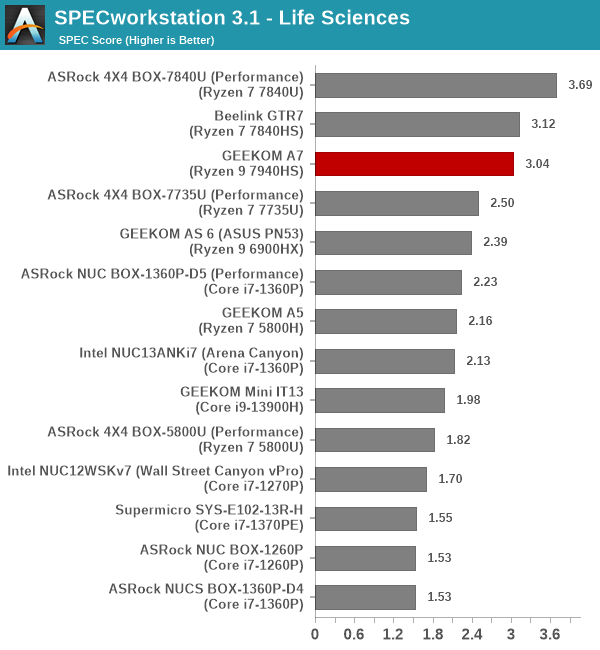
Financial Services
The Financial Services workload set benchmarks the system for three popular algorithms used in the financial services industry - the Monte Carlo probability simulation for risk assessment and forecast modeling, the Black-Scholes pricing model, and the Binomial Options pricing model.
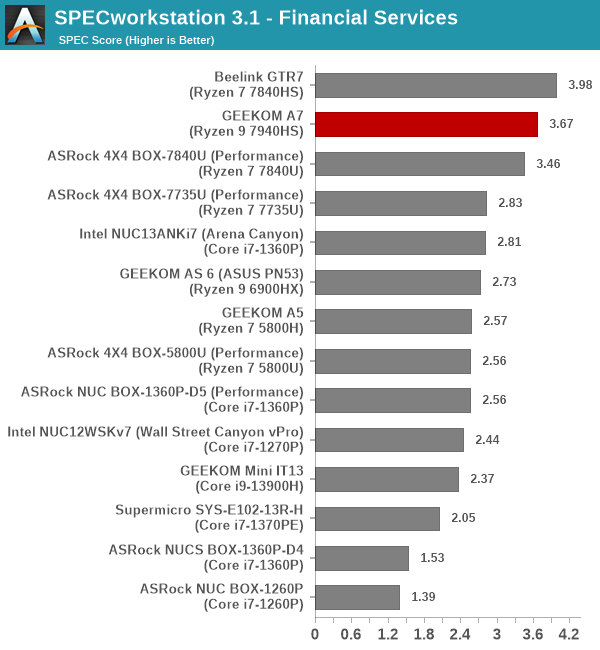
Energy
The Energy category comprises of workloads simulating various algorithms used in the oil and gas industry:
- The FFTW workload computes discrete Fourier transforms of large matrices.
- The Convolution workload computes the convolution of a random 100x100 filter on a 400 megapixel image.
- The SRMP workload processes the Surface-Related Multiples Prediction algorithm used in seismic data processing.
- The Kirchhoff Migration workload processes an algorithm to calculate the back propogation of a seismic wavefield.
- The Poisson workload takes advantage of the OpenMP multi-processing framework to solve the Poisson's equation.
- The Energy workload uses the energy-02 viewset from SPECviewperf 13 to determine system performance for the open-source OPendTec seismic visualization application.
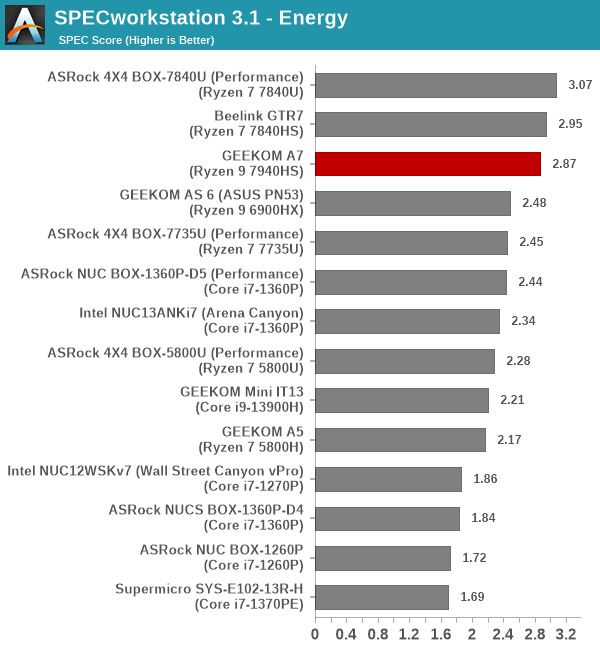
General Operations
In the General Options category, the focus is on workloads from widely used applications in the workstation market:
- The 7zip workload represents compression and decompression operations using the open-source 7zip file archiver program.
- The Python workload benchmarks math operations using the numpy and scipy libraries along with other Python features.
- The Octave workload performs math operations using the Octave programming language used in scientific computing.
- The Storage workload evaluates the performance of the underlying storage device using transaction traces from multiple workstation applications.
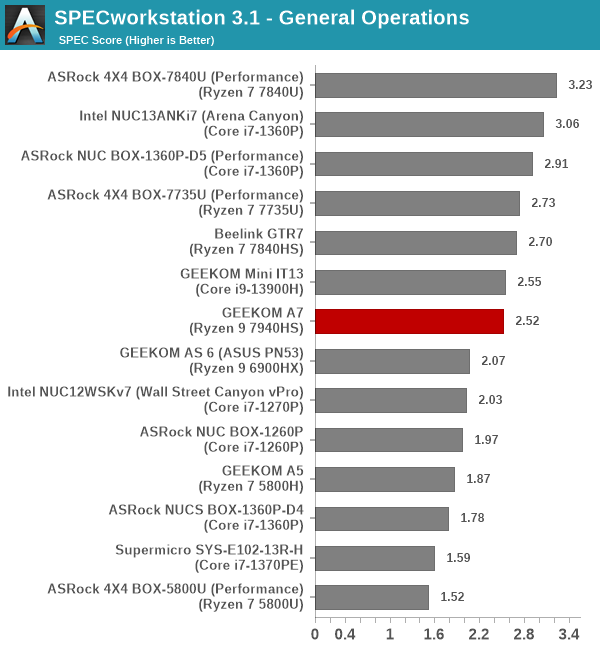
GPU Compute
In the GPU Compute category, the focus is on workloads taking advantage of the GPU compute capabilities using either OpenCL or CUDA, as applicable:
- The LuxRender benchmark is the same as the one seen in the media and entertainment category.
- The Caffe benchmark measures the performance of the Caffe deep-learning framework.
- The Folding@Home benchmark measures the performance of the system for distributed computing workloads focused on tasks such as protein folding and drug design.
We only process the OpenCL variants of the benchmark, as the CUDA version doesn't process correctly with default driver installs.
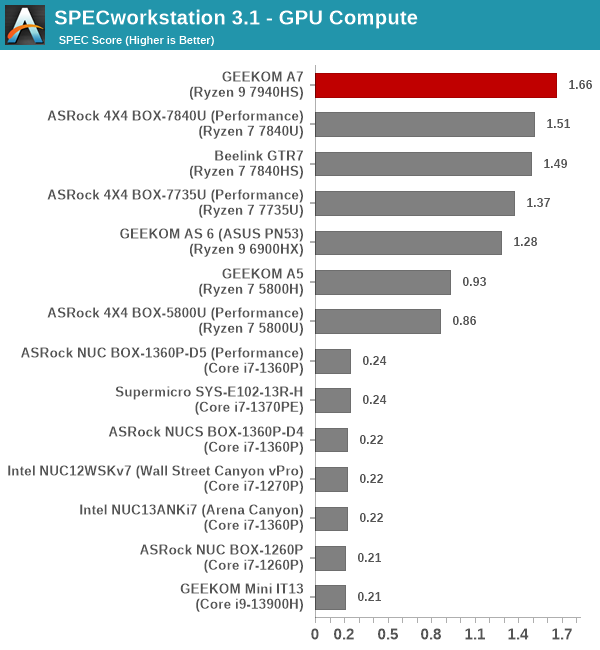
Workloads processed on workstations are long-running tasks that don't benefit in any meaningful way from short bursts of higher power. UCFF systems find it difficult to sustain these higher package power numbers for a long enough time to influence the performance in workstation benchmarks. As a result, the relative performance of the GEEKOM A7 in SPECworkstation v3.1 is dictated by its sustained package power limit of 35W. Due to this, the 65W configurations find themselves above the A7 in most workload sets. To its credit, the A7 continues to remain in the top 3 despite the handicap in the power budget.










18 Comments
View All Comments
TheinsanegamerN - Friday, May 31, 2024 - link
I feel like I'd be much more excited about these when we get a strix halo version.The Hardcard - Friday, May 31, 2024 - link
The problem is by the time of the review, there will be so many details leaked about Zen 6 products that your excitement for Strix Halo will be crushed.kn00tcn - Friday, May 31, 2024 - link
did you forget what strix halo will be? the single biggest leap in gpu size in any apu ever, it's extremely unlikely that the gen right after that would somehow leap again unless integrated gddr is usedt.s - Saturday, June 1, 2024 - link
bingo!meacupla - Friday, May 31, 2024 - link
The one shortcoming of all these startup mini-PC brands is longer term BIOS support.My 2020 AMD Renoir Dell laptop still gets occasional BIOS updates, but the same cannot be said of the trigkey, kamrui, or bosgame mini-PCs that I have kicking around.
Desierz - Friday, May 31, 2024 - link
Have you considered if they really need BIOS updates?PeachNCream - Friday, May 31, 2024 - link
They generally work with release BIOS versions but its quite common to see updates later resolve problems or enhance relaibility so after sales support can a significant consideration.kn00tcn - Friday, May 31, 2024 - link
have you considered agesa updates have already contained important memory, usb, and security updates multiple times in the past?meacupla - Friday, May 31, 2024 - link
They do. One of them is missing a critical fix for Zen bleed. So it's missing Agesa 1.2.0.bkn00tcn - Friday, May 31, 2024 - link
those sound like random aliexpress 'brands', while geekom or minisforum have been established worldwide names by contrast (not that i've checked their updates, even majors like asrock are disappointing for agesa updates on deskmini/deskmeet)